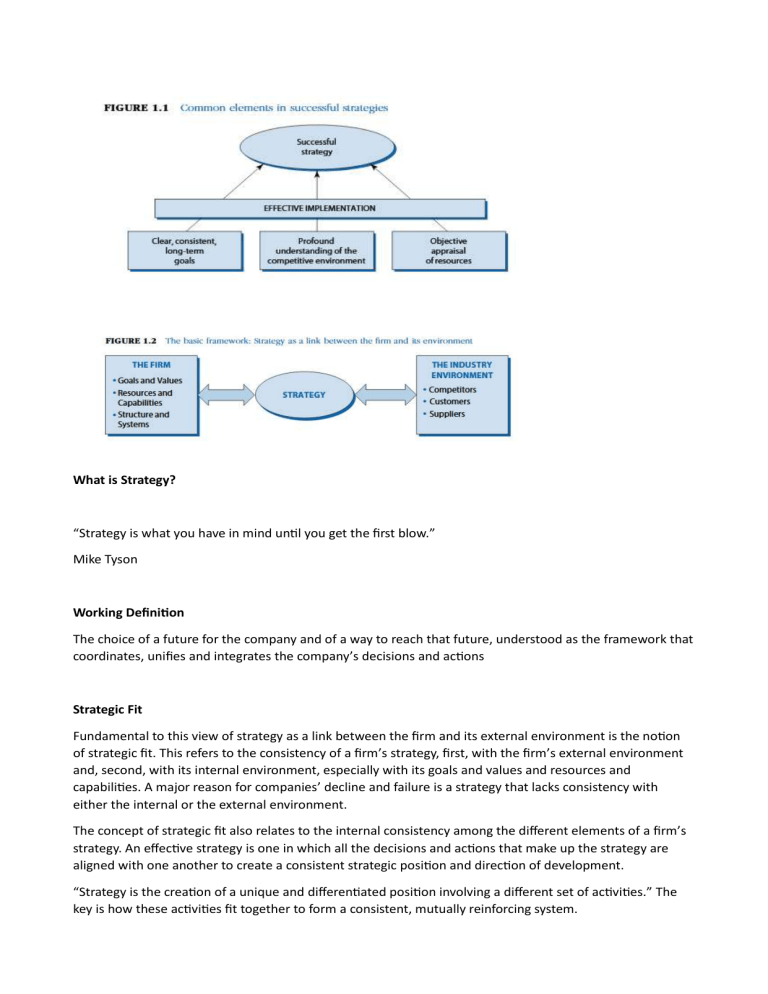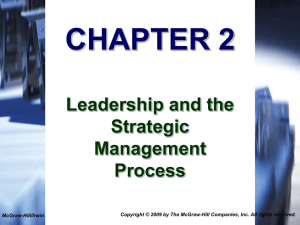
What is Strategy? “Strategy is what you have in mind until you get the first blow.” Mike Tyson Working Definition The choice of a future for the company and of a way to reach that future, understood as the framework that coordinates, unifies and integrates the company’s decisions and actions Strategic Fit Fundamental to this view of strategy as a link between the firm and its external environment is the notion of strategic fit. This refers to the consistency of a firm’s strategy, first, with the firm’s external environment and, second, with its internal environment, especially with its goals and values and resources and capabilities. A major reason for companies’ decline and failure is a strategy that lacks consistency with either the internal or the external environment. The concept of strategic fit also relates to the internal consistency among the different elements of a firm’s strategy. An effective strategy is one in which all the decisions and actions that make up the strategy are aligned with one another to create a consistent strategic position and direction of development. “Strategy is the creation of a unique and differentiated position involving a different set of activities.” The key is how these activities fit together to form a consistent, mutually reinforcing system. The concept of strategic fit is one component of a set of ideas known as contingency theory. Contingency theory postulates that there is no single best way of organizing or managing. The best way to design, manage, and lead an organization depends upon circumstances—in particular, the characteristics of that organization’s environment. Origins and Military Antedecents Whereas tactics are concerned with the maneu-vers necessary to win battles, strategy is concerned with winning the war. Strategic decisions, whether in military or business spheres, share three common characteristics: ●They are important. ●They involve a significant commitment of resources. ●They are not easily reversible. From Corporate Planning to stretegic Management During the 21st century, new challenges have continued to shape the princi-ples and practice of strategy. Digital technologies have had a massive impact on the competitive dynamics of many industries, creating winner-take-all markets and standards wars. Disruptive technologies and accelerating rates of change have meant that strategy has become less and less about plans and more about creating options of the future, fostering strategic innovation, and seeking the “blue oceans” of uncontested market space. The complexity of these challenges has meant that being self-sufficient is no longer viable for most firms—alliances and other forms of collaboration are an increasingly common feature of firms’ strategies. What Is Strategy? In its broadest sense, strategy is the means by which individuals or organizations achieve their objectives. Common to most definitions is the notion that strategy involves setting goals, allocating resources, and establishing consistency and coherence among decisions and actions. As the business environment has become more unstable and unpredictable, so strategy has become less concerned with detailed plans and more about guidelines for success. This shift in emphasis from strategy as plan to strategy as direction does not imply any downgrading of the role of strategy. The more turbulent the environment, the more strategy must embrace flexibility and responsiveness. But it is precisely under these conditions that strategy becomes more, rather than less, important. Why do firms need strategy? Strategy assists the effective management of organizations, first, by enhancing the quality of decisionmaking, second, by facilitating coordination, and, third, by focusing organizations on the pursuit of longterm goals. Strategy as Decision Support Strategy is a pattern or theme that gives coherence to the decisions of an individual or organization. Strategy improves decision-making in several ways: ●It simplifies decision-making by constraining the range of decision alternatives considered and acting as a heuristic—a rule of thumb that reduces the search required to find an acceptable solution to a decision problem. ●The strategy-making process permits the knowledge of different individuals to be pooled and integrated. ● It facilitates the use of analytic tools—the frameworks and techniques that we will encounter in the ensuing chapters of this book. Strategy as a Coordinating Device The central challenge of management is coordinating the actions of multiple organizational members. Strategy acts as a communication device to promote coordination. Statements of strategy are a means by which the CEO can communicate the identity, goals, and positioning of the company to all organizational members. Once formulated, strategy can be translated into goals, commitments, and performance targets that ensure that the organization moves forward in a consistent direction. Strategy as Target Strategy is forward looking. It is concerned not only with how the firm will compete now, but also with what the firm will become in the future. A forward-looking strategy establishes direction for the firm’s development and sets aspirations that can motivate and inspire members of the organization. Gary Hamel and C. K. Prahalad use the term strategic intent to describe this desired strategic position: “strategic intent creates an extreme misfit between resources and ambitions. Top management then challenges the organization to close the gap by building new competitive advantages.” However, goals on their own do not constitute a strategy. Unless an organization’s goals are backed by guidelines for their attainment, they are likely to be either meaningless or delusional. Where Do We Find Strategy? Strategy has its origins in the thought processes of organizational leaders. In large companies, strategy formulation is an explicit management process and statements of strategy are found in board minutes and strategic planning documents, which are inva-riably confidential. However, most companies—public companies in particular—see value in communicating their strategy to employees, customers, investors, and business partners. Collis and Rukstad identify four types of statement through which companies communicate their strategies: ●The mission statement describes organizational purpose; it addresses “Why we exist.” ●A statement of principles or values outlines “What we believe in and how we will behave.” ●The vision statement projects “What we want to be.” ●The strategy statement articulates the company’s competitive game plan, which typically describes objectives, business scope, and advantage. All these are intentions and, as we shall see, strategic intent is not necessarily real-ized. Ultimately, strategy is realized as action. Hence, strategy is observable in where and how a firm chooses to compete. For example, information on a firm’s business scope (products and its markets) and how it competes within these markets can be found in a company’s annual reports. Checking a company’s pronouncements about strategy against its decisions and actions may reveal a gap between rhetoric and reality. As a reality check upon grandiose and platitudinous sentiments of vision and mission, it is useful to ask: ●Where is the company investing its money? Notes to financial statements provide detailed breakdowns of capital expenditure by region and by business segment. ●What technologies is the company developing? Identifying the patents that a company has filed (using the online databases of the US and EU patent offices) indicates the technological trajectory a firm is pursuing. ●What new products have been released, major investment projects initiated, and top management hired? These strategic decisions are typically announced in press releases and reported in trade journals. Corporate and Business StrategyStrategic choices can be distilled into two basic questions: ●Where to compete? ●How to compete? The answers to these questions define the two major areas of a firm’s strategy: corporate strategy and business strategy Corporate strategy defines the scope of the firm in terms of the industries and markets in which it competes. Corporate strategy decisions include choices over diversification, vertical integration, acquisitions, and new ventures, and the allocation of resources between the different businesses of the firm. Business strategy is concerned with how the firm competes within a particular industry or market. If the firm is to prosper within an industry, it must establish a competitive advantage over its rivals. Hence, this area of strategy is also referred to as competitive strategy The distinction between corporate strategy and business strategy corresponds to the organizational structure of most large companies. Corporate strategy is the responsibility of corporate top management. Business strategy is primarily the responsibility of the senior managers of divisions and subsidiaries. However, our primary emphasis will be on business strategy. This is because the critical requirement for a company’s success is its ability to establish competitive advantage. Hence, issues of business strategy precede those of corporate strategy. At the same time, these two dimensions of strategy are intertwined: the scope of a firm’s business has implications for the sources of competitive advantage, and the nature of a firm’s competitive advantage determines the industries and markets it can be successful in. Describing Strategy These same two questions—“Where is the firm competing?” and “How is it competing?”—also provide the basis upon which we can describe the strategy that a firm is pursuing. The where question has multiple dimensions. It relates to the products the firm supplies, the customers it serves, the countries and localities where it operates, and the vertical range of activities it undertakes. The how question relates to the nature of the firm’s competitive advantage: Is it seeking a cost advantage or a differentiation advantage? How is the firm using its distinctive resources and capabilities to establish a competitive advantage? This dynamic aspect of strategy involves establishing objectives for the future and determining how they will be achieved. Future objectives relate to the overall purpose of the firm (mission), what it seeks to become (vision), and how it will meet specific performance targets.These two dimensions of strategy—the static and the dynamic. How is strategy made? The strategy Process Strategy may also be made informally: emerging through adaptation to circumstances. Similarly, successful companies are seldom the products of grand designs. The rise of Apple Inc. to become the world’s most valuable company (in terms of stock market capitalization) has often been attributed to a brilliant strategy of inte-grating hardware, software, and design aesthetics to create electronic products that offered a unique consumer experience. Yet, there is little evidence that Apple’s incredible success since 2004 was the result of an explicit strategy. Design versus Emergence Henry Mintzberg distinguished intended, emergent, and realized strategies. Intended strategy is strategy as conceived of by the leader or top management team. Even here, intended strategy may be less a product of rational deliberation and more an outcome of inspiration, negotiation, bargaining, and compromise among those involved in the strategy-making process. However, realized strategy—the actual strategy that is implemented—is only partly related to that which was intended. The primary determinant of realized strategy is what Mintzberg terms emergent strategy—the decisions that emerge from the complex processes in which individual managers interpret the intended strategy and adapt it to changing circumstances. The emergent approaches to strategy-making permit adaptation and learning through a continuous interaction between strategy formulation and strategy implementation in which strategy is constantly being adjusted and revised in the light of experience. Stretegy making involves both thought and action. ●The design aspect of strategy comprises organizational processes through which strategy is deliberated, discussed, and decided. These include board meetings, a strategic planning process, and informal participative events, such as strategy workshops. ●The enactment of strategy through decisions and actions being taken throughout the organization is a decentralized process where middle managers play a central role. These emergent processes are typically viewed as occurring when formal strategic plans are being implemented. However, these emergent processes may come first. operational decisions of business unit and plant managers can be subsequently adopted as strategy by top management. I refer to this process of strategy-making that combines design and emergence as “planned emergence.” The balance between the two depends greatly upon the stability and predictability of the organization’s business environment. As the business environment becomes more turbulent and less predictable, so strategy-making becomes less about detailed decisions and more about guidelines and general direction. Applying Strategy Analysis whether strategy formulation is formal or informal, deliberate or emergent, systematic analysis leads to better decisions and helps protect strategic decision-making from power battles, whims, fads, and wishful thinking. Concepts, theories, and analytic tools are comple-ments to, and not substitutes for, intuition and creativity, and they provide a framework for organizing discussion, processing information, and developing consensus. We must also recognize limitations of strategy analysis. Unlike many of the analytical techniques in accounting, finance, strategy analysis does not offer algorithms or formulae that tell us the optimal strategy to adopt. The purpose of strategy analysis is not to provide answers but to help us to probe the relevant issues. By providing a framework that allows us to examine the factors that influence a strategic situation and organize relevant information, strategy analysis places us in a superior position to a manager who relies exclusively on experience and intuition. Developing a strategy for a business typically involves four main stages: 1. Setting the strategic agenda. Any strategy-making exercise must begin by iden- tifying the important issues that the strategy must address. For an existing company, this involves assessing whether the current strategy is working, which requires that we: ●Identify the current strategy. A vital preliminary step is to establish consensus around what the current strategy is. The above sections on Where Do We Find Strategy? and Describing Strategy offer guidance in this. ●Appraise performance. How well is the current strategy performing? Apply financial analysis. 2. Analyzing the situation ● Diagnose performance. Having determined the level and trend of the firm’s performance, the next challenge is diagnosis: In the case of poor performance, what are the sources of unsatisfactory performance? In the case of good performance, what are the factors driving this? ●Industry analysis. To determine whether the current strategy needs to be changed, we need to look not just at how it is currently performing, but how it will perform in the future ●Analysis of resources and capabilities. Having established likely external changes, what do these mean for the firm’s competitive position? Analysis of the firm's resources and capablities. 1. Formulating strategy. Performance diagnosis, industry analysis, and resource and capability analysis provide a basis for generating strategic options, the most promising of which can be developed into a recommended strategy. Recommended strategies tend to avoid precise specifications of what is to be done, they are more likely to articulate the primary basis for a firm’s competitive advantage and what this means for how it will compete. Chapter 7 discusses how the intersection of internal strengths and external success factors create the basis for a firm’s competitive advantage. 4. Implement strategy. Without action, a strategy is merely an idea expressed in words. Implementing strategy requires allocating resources and motivating people. As we shall see in Chapter 6, this requires putting in place the organizational structure and management systems within which action can take place. Strategic for Non-Profit organization The principles and tools of strategic management have been developed primarily for business enter-prises; however, they are also applicable to the strategic management of not-for-profit organizations, especially those that inhabit competitive environments.


